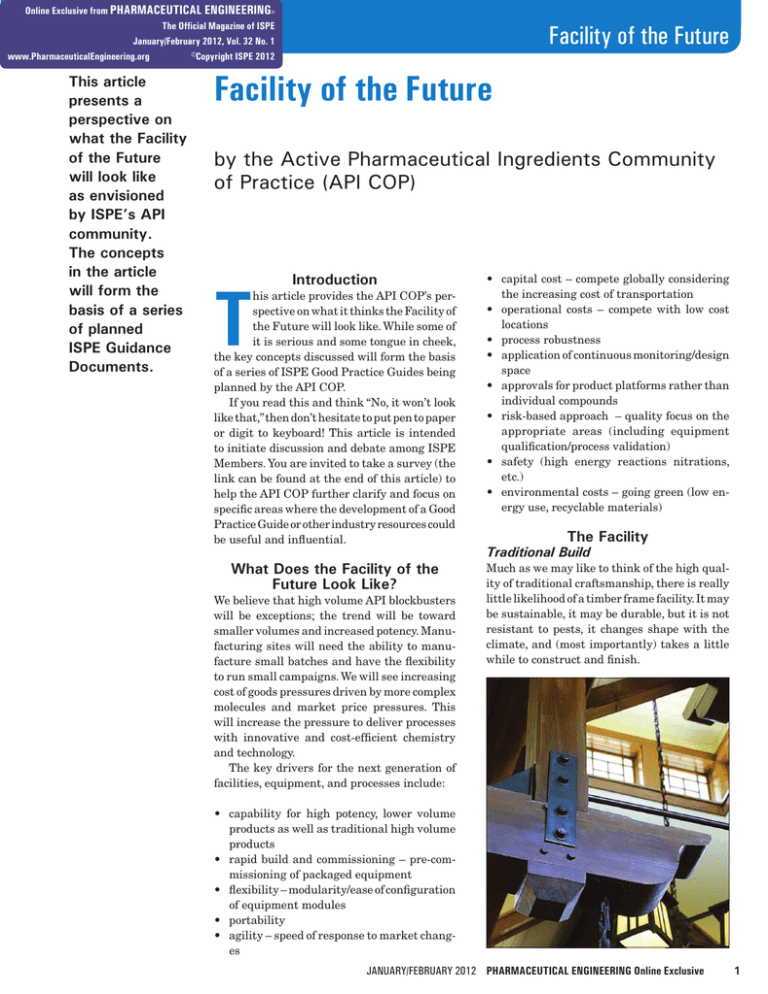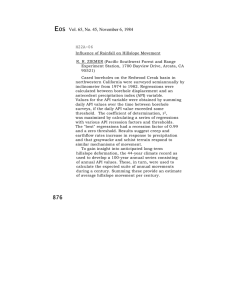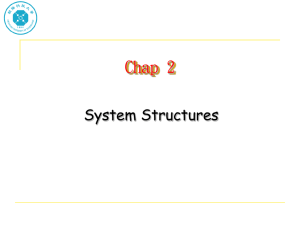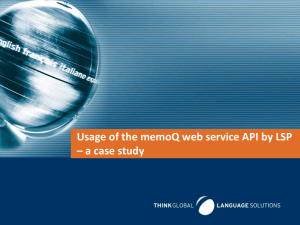Facility of the Future
advertisement

Online Exclusive from PHARMACEUTICAL ENGINEERING® The Official Magazine of ISPE January/February 2012, Vol. 32 No. 1 www.PharmaceuticalEngineering.org ©Copyright ISPE 2012 This article presents a perspective on what the Facility of the Future will look like as envisioned by ISPE’s API community. The concepts in the article will form the basis of a series of planned ISPE Guidance Documents. Facility of the Future Facility of the Future by the Active Pharmaceutical Ingredients Community of Practice (API COP) T Introduction his article provides the API COP’s perspective on what it thinks the Facility of the Future will look like. While some of it is serious and some tongue in cheek, the key concepts discussed will form the basis of a series of ISPE Good Practice Guides being planned by the API COP. If you read this and think “No, it won’t look like that,” then don’t hesitate to put pen to paper or digit to keyboard! This article is intended to initiate discussion and debate among ISPE Members. You are invited to take a survey (the link can be found at the end of this article) to help the API COP further clarify and focus on specific areas where the development of a Good Practice Guide or other industry resources could be useful and influential. What Does the Facility of the Future Look Like? We believe that high volume API blockbusters will be exceptions; the trend will be toward smaller volumes and increased potency. Manufacturing sites will need the ability to manufacture small batches and have the flexibility to run small campaigns. We will see increasing cost of goods pressures driven by more complex molecules and market price pressures. This will increase the pressure to deliver processes with innovative and cost-efficient chemistry and technology. The key drivers for the next generation of facilities, equipment, and processes include: • capital cost – compete globally considering the increasing cost of transportation • operational costs – compete with low cost locations • process robustness • application of continuous monitoring/design space • approvals for product platforms rather than individual compounds • risk-based approach – quality focus on the appropriate areas (including equipment qualification/process validation) • safety (high energy reactions nitrations, etc.) • environmental costs – going green (low energy use, recyclable materials) The Facility Traditional Build Much as we may like to think of the high quality of traditional craftsmanship, there is really little likelihood of a timber frame facility. It may be sustainable, it may be durable, but it is not resistant to pests, it changes shape with the climate, and (most importantly) takes a little while to construct and finish. • capability for high potency, lower volume products as well as traditional high volume products • rapid build and commissioning – pre-commissioning of packaged equipment • flexibility – modularity/ease of configuration of equipment modules • portability • agility – speed of response to market changes January/February 2012 PHARMACEUTICAL ENGINEERING Online Exclusive 1 Facility of the Future Rapid Build No to all of the above; well, it’s not really likely, is it! What is more likely is a standard rapid build form of construction, such as tilt up or pre-stressed concrete or steel frame with precast panels – this use of “standard” modules would allow a very rapid construction of a weathertight enclosure so that internal work can take place regardless of external weather conditions. Internal construction can then proceed using: • traditional methods – metal studwork and sheetrock with suitable finishes • standard panel cleanroom systems Tudor (1500's) Timber Frame House in York (UK). Other options that are potential solutions to the requirement of minimum times on site: • Internal fit out with premade process modules; each box containing a platform standard module. • The main building may provide the administrative and general support areas with the transit corridor allowing prefabricated modules with all the process equipment to be located and placed onto the main building. • Another option may be the use of “standard” size open areas dedicated to a production line – all standard size with an opening that will allow dedicated process modules to be exchanged depending on the market demand. The Manufacturing Environment Brickmaking in the UK! What about a slightly more modern approach – put up a brick kiln and build a brick building. No chance there then – slower to build and more expensive, but perhaps more robust and attractive. Modern Brick built house (1714) York (UK). 2 • API manufacturing is done with closed processes, obviating the need for controlled environments, except for control of chemical and potent product exposure. • Biotech processes are completely closed with true-aseptic sampling that again minimizes the need for controlled environments. • The biotech area of the facility is designed with open spaces, cleanable finishes, coved floors and ceilings to maintain the appearance of a high quality manufacturing facility, with no "pre viral" and "post viral" facility separation. All separation is in the equipment trains. • The process equipment is made up of close coupled equipment, with a mobile Laminar Air Flow (LAF) that can be moved down the line to provide high quality protection to any open ports where addition is required. • In normal operation, the equipment is pressurized by nitrogen or clean air after Clean-in-Place (CIP) and Steamin-Place (SIP), providing protection of the product. • The charging operation is fully contained within an isolator, equipped with CIP/SIP. • The charging operation could also be Blow/Fill/Seal (BFS), fully contained in a low grade background. • The charging equipment is fully robotic - no glove ports, no operator interventions. • Lighting and HVAC occupied/unoccupied set points are controlled by occupancy detectors. • Open process cleanrooms utilize adaptive control of airflow and velocity. PHARMACEUTICAL ENGINEERING Online Exclusive January/February 2012 Facility of the Future • 100% OA units are no longer used for any application except hazardous gases. Appropriate filtration and particle monitoring control cross-contamination and operator exposure where necessary. Process Technologies The introduction of innovative technology and continuous processing brings with it many new opportunities in the area of operations. In the recent past, the pharmaceutical industry has almost exclusively focused on batch processing due to the flexibility of multipurpose batch manufacturing plants. The ideal API process would implement the best and lowest cost process and process equipment for each unit operation. Should the plant of the future be constrained to a single processing philosophy? Batch process technology is flexible, widely available, and applicable across a range of scale. It has been used successfully for many chemistries and for many unit operations. Limitations in mixing, heat transfer, and mass transfer make it less than optimal for many operations, yet the performance is frequently adequate and in some cases very good. Fully continuous processing replaces the batch paradigm with a flow paradigm, utilizing operation specific technology at each step of the process. The ultimate vision for continuous processing has raw materials entering the process and fully tested drug product discharging at the other end, even moving directly to packaging. This vision eliminates all areas where the process is not actively moving forward to the final product. Or can we have the best of both worlds? Hybrid processing can be thought of as a combination of standard batch technology with new/innovative/continuous technology. Specific operations are targeted for improved performance utilizing technology designed for that specific process requirement. A hybrid process might use new technology for a single, specific operation or for an entire portion of a process. Examples of hybrid processing include: a. Coupling a continuous reaction with batch work-up, crystallization, and isolation. b. Coupling a batch reaction with a continuous work-up step (separation, extraction, distillation), followed by additional batch processing. c. Coupling batch processing with continuous crystallization. With multiple options available, it is important to determine which choice will achieve the best cost/benefit ratio for the Facility of the Future. This requires discerning which benefits are available (because the technology enables improved chemical/productivity outcomes) and which benefits are inherent in the application of new technology (even if the chemistry/ productivity outcomes remain the same). Potential Areas of Focus This includes: • Use of portable or single-use equipment. • Robust equipment design and lower in-situ total system energy to enable safe operation of chemistry deemed too hazardous for traditional batch equipment. • PI/continuous processes to offer increased concentration, better selectivity, and improved yields resulting in less waste. • Green guidelines including capabilities for recycling operations and use of energy-efficient equipment. • Contained manufacture of highly potent or toxic drug substances. • Process control to provide enhanced process knowledge and facilitate. • Real time release in lieu of end product testing. Process Development and Design Pharmaceutical companies are looking at process design differently these days. With the addition of new technologies and continuous processing come new opportunities to integrate chemistry, engineering, and process modeling to achieve lower cost and better process understanding. The development and design of these processes will require a multidisciplinary approach. A variety of design and modeling tools will be necessary to make process development most efficient. Leveraging the strengths of both research and manufacturing during process development and design will drive down manufacturing costs earlier in the product lifecycles, but require integrated working across departments. Utility Systems • The site potable water is monitored to ensure that it remains in the expected seasonal range for conductivity, TOC, and microbial levels. • The Purified Water (PW) system operates on a stop start basis with online monitoring of the microbial levels – if increases are seen on system start up, then the system is heat sanitized. The total microbial levels as well as conductivity and TOC are monitored continuously and used to confirm that the system is fit for use. • The WFI is generated from an additional UF stage on the PW system, with independent monitoring systems. • WFI recirculated after use in areas where there is no product exposure, e.g., vial washing is recycled back through a ceramic UF to the WFI polish stage. • The compressed air system uses water lubricated high efficiency compressors to supply the site demand, the heat generated from compression is used to regenerate the desiccant dryer. The air is continuously monitored for total particulate, pressure dew point, and hydrocarbon levels. • The majority of the controlled valves in the utility systems are electrically driven. Any adverse trends in system performance will cause a local alert alarm in the production areas, with an action alarm if the system performance exceeds acceptable limits. January/February 2012 PHARMACEUTICAL ENGINEERING Online Exclusive 3 Facility of the Future Conclusion: What About the Ultimate Vision? It is helpful to have an ultimate vision of where innovative technology might lead (with respect to equipment, process, plant, and organization). Without an ultimate vision, barriers (real and imagined) can result in inertia providing the greatest barrier of all. Vision provides the impetus to keep moving. The vision in this case is integrated API and drug product manufacture. A single-factory manufacture of Drug Product (DP) starting from excipients and API intermediates. This would be an integrated facility with real time release of API into DP, minimum or zero API storage, and very fast supply chain response. Processes would be developed by a single development team enabling them to deal with linkages between API and DP without organizational barriers. Could there even be more to the ultimate vision? When thinking about the future of the pharmaceutical industry as a whole, we cannot forget the growing focus on personalized medicines. This could lead to much greater numbers of very low volume products. These APIs are likely to be complex and difficult to make. How will our facility of the future look like in order to meet this demand? A highly automated unit or skid capable of making a myriad of minor changes, either individually or in multiple combinations, would be highly desirable. This also could then lead to more production on demand where the medicines are not made until the prescriptions are written. About the API COP The API COP proactively advocates the importance of API in the drug product delivery process with the objectives of providing a forum for members to discuss issues of common interest. Image Sources Photo 1: http://www.hearthstonehomes.com/commercial_ structures.html Photo 2: http://www.yorkhistoryinpictures.co.uk/tudor_stuart.html Photo 3: http://www.google.com/imgres?q=hand+brick+m aking+in+the+UK&hl=en&sa=X&rls=com.microsoft:en-u s&biw=1920&bih=952&tbm=isch&prmd=imvns&tbni d=_yURbJLzQl8_5M:&imgrefurl=http://madpotter-oldcanalpottery.blogspot.com/&docid=MpBf2L8EmnlJNM&imgurl=h ttp://1.bp.blogspot.com/-_IP_KVR-ODs/Tg9U8bvO32I/AAAA AAAAAdo/2NvV2v7Q4wM/s1600/todd%25252527sbrick1910. JPG&w=1600&h=1227&ei=JPYET-uLN8mriAKon7CUDQ &zoom=1&iact=hc&vpx=1279&vpy=304&dur=296&hovh= 197&hovw=256&tx=173&ty=146&sig=11528888516088437 5757&page=1&tbnh=136&tbnw=177&start=0&ndsp=45&v ed=1t:429,r:15,s:0 Photo 4: http://www.yorkhistoryinpictures.co.uk/tudor_stuart.html Take the Survey, Shape the Industry We want your feedback on the concepts discussed in this article. Take the survey and help guide the industry toward your vision of the API Small Molecule Plant of the Future. There is a dedicated section at the end of the survey for your own serious or tongue in cheek comments. Here is the link to the survey: http://apismallmoleculeplantofthefuture.questionpro.com/ 4 PHARMACEUTICAL ENGINEERING Online Exclusive January/February 2012






